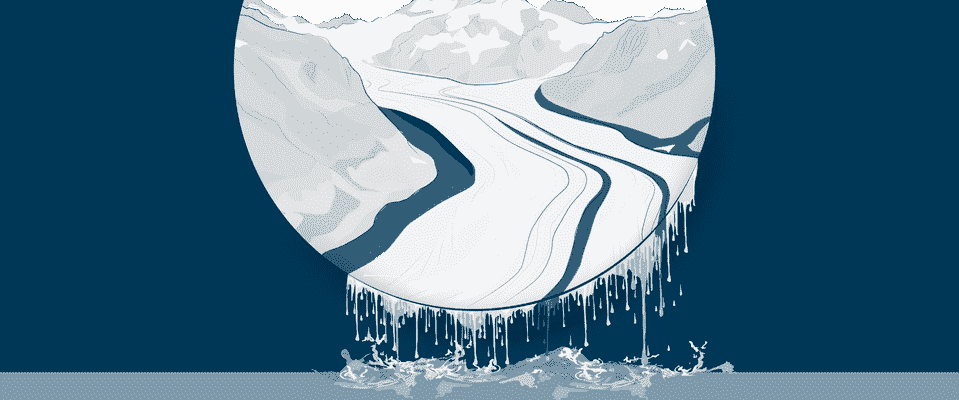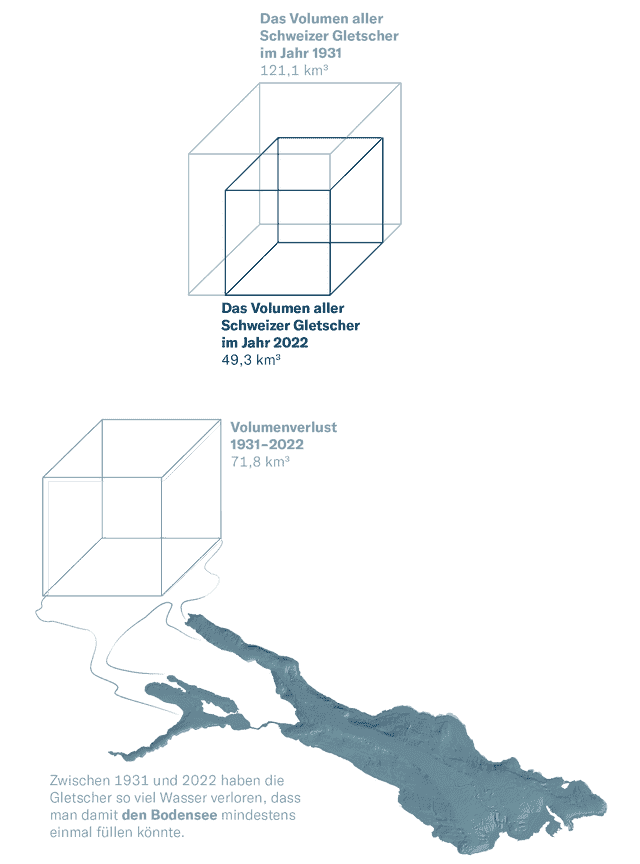Not enough snow fell in winter, and heat waves began as early as May. According to glaciologists, the retreat of the glaciers in the last 12 months exceeded the previous record year 2003. An overview with many graphics.
During the summer, glaciologists had repeatedly reported dismayed about the melting ice in the Swiss Alps. Now there is certainty: the previous record loss of 2.9 cubic kilometers from 2003 has been surpassed: last year the glaciers lost 3.1 cubic kilometers of ice, more than 6 percent of their volume.
Glaciologists from the Swiss Glacier Monitoring Network (Glamos) presented these record numbers on Wednesday. Every year between the end of September and the beginning of October, the experts take stock of the country’s ice tongues. A comparison illustrates the extreme shrinkage of 2022: If all the meltwater had been collected in July and August, all the reservoirs in the Swiss Alps could have been completely filled with it.
Several small glaciers have been completely wiped out in recent months: the Pizol glacier in the canton of St. Gallen, the Vadret dal Corvatsch in Graubünden and the Schwarzbachfirn in Uri – they all no longer exist.
Rocks appear in the middle of the ice
Larger ice tongues also show clear signs of decay in some cases. “Some glaciers begin to split up so that a rock appears in the middle of the ice,” says Matthias Huss, head of Glamos, who works at ETH Zurich.
The ice thickness decreased by about 3 meters on average. In the Engadin and in the south of Valais, the loss at an altitude of more than 3000 meters was even around 4 to 6 meters. The retreat of the glacier could also be felt on the Jungfraujoch, the highest site where glaciological measurements were taken.
Since 1850, the glaciers have lost a lot in area
There are – or one should say: there have been up to now – far more than 1000 glaciers in Switzerland, especially at high altitudes around the main Alpine ridge. The ice tongues are a huge water reservoir and are therefore of great importance for the country’s climate. If they were gone, many things would change.
Unsurprisingly, the largest volume of glaciers in the country can be found in the canton of Valais, where most of the four-thousanders are towering. By far the largest tongue of ice in Switzerland is the Aletsch Glacier, with a volume of almost eleven cubic kilometers.
Why have glaciers lost so much volume this summer?
This year many things unfavorable for the ice have come together. It started with the winter not bringing enough snow, especially on the southern side of the Alps. In the spring, Saharan dust was then transported in several waves – it colored the snow orange, causing it to reflect less sunlight. That also contributed to the meltdown.
The heat waves started in May. In addition, it was extremely dry this summer. By mid-September there had only been a few centimeters of fresh snow in the high mountains, as the Glamos experts announced.
The glaciers are not in balance
In the course of climate change, the shrinkage will continue in the future. Due to the lack of snow and the high temperatures, an important theoretical line shifts on the glacier: the equilibrium line. It separates the area where the glacier is gaining ice from the area where it is losing ice. Due to global warming, the line is moving higher and higher.
If the temperature has risen and then stopped at a higher level, a glacier will eventually stabilize again. But it takes time to do that – and the bigger it is, the longer it takes. At the moment, all of Switzerland’s ice tongues are far from equilibrium. They have not yet adjusted to the previous rise in temperature. That means they would all continue to shrink even if warming suddenly stopped.
Glacier volume has declined sharply since 1931
Up until around 1850, the glaciers in Switzerland were even growing. This was a problem for some villages, because at that time some ice tongues pushed forward into the valleys. Glaciers have lost almost 60 percent of their volume since 1931.
What happens when no more water comes out of the glaciers?
In the drought summer of 2022, the meltwater from the glaciers partially masked the water shortage in the rivers, says Matthias Huss. But if there are fewer glaciers in the mountains in the future, the water in the rivers could become scarce much more quickly if there is no rain in summer. In southern Italy and in Spain, where there are almost no glaciers, you can already see what that will look like. So the biggest problem of glacier melt is not in the present at all, it will only come in the future.
The Rhine is also partly fed by meltwater from glaciers. What will happen to this share in the future was recently discussed in a big German-Swiss project examined. Accordingly, the proportion of meltwater in the Rhine continues to decrease. By the year 2100, this influx will have almost entirely dried up.
The consequences will be particularly evident in the summer. Normally, the Rhine level does not fall below a certain level during a drought, because a considerable amount of meltwater comes from the glaciers. This contribution will become smaller and smaller in the future and at some point, when the glaciers no longer exist, it will be completely absent.
The researchers therefore predict that the Rhine level will drop to extremely low values more and more often in the future. They expect the strongest decline between July and September, and this also applies to tributaries such as the Aare and Reuss.
Will this extreme glacier shrinkage continue in the next few years?
According to glaciologist Huss, the strong melt was to be expected due to the extreme weather conditions of recent months. He does not expect that next year will be another record year. But to be on the safe side, the glaciologists have drilled the rods with which they measure the thickness of the melting ice sheet deeper this time than in the past. So that they don’t immediately fall out of the ice in similarly warm conditions.
The record shrinkage of the past year was only a foretaste if one trusts the scenarios for the future. Unless the global emission of greenhouse gases can be drastically reduced, hardly any of Switzerland’s glaciers outside of the Valais will survive by the year 2100 – and even there only those ice tongues that are located at very high altitudes.
Text: Sven Titz. Design, infographic: Anja Lemcke. Data: Florian Seliger. cards: Roland Shaw. Graphic collaboration: Jonas Oesch.
Sources for the glacier extent map.
1850: Maisch, M., Wipf, A., Denneler, B., Battaglia, J., and Benz, C. (2000). The glaciers of the Swiss Alps: Glacier high point in 1850, current glaciation, glacier retreat scenarios. Final Report NRP 31. Second edition. Zurich: VDF university publisher ETH Zurich, 373 p.
2016: Linsbauer, A., Huss, M., Hodel, E., Bauder, A., Fischer, M., Weidmann, Y., Bärtschi, H. & Schmassmann, E. 2021, The new Swiss Glacier Inventory SGI2016: From a topographical to a glaciological dataset. Frontiers in Earth Science, 22, doi:10.3389/feart.2021.704189.

